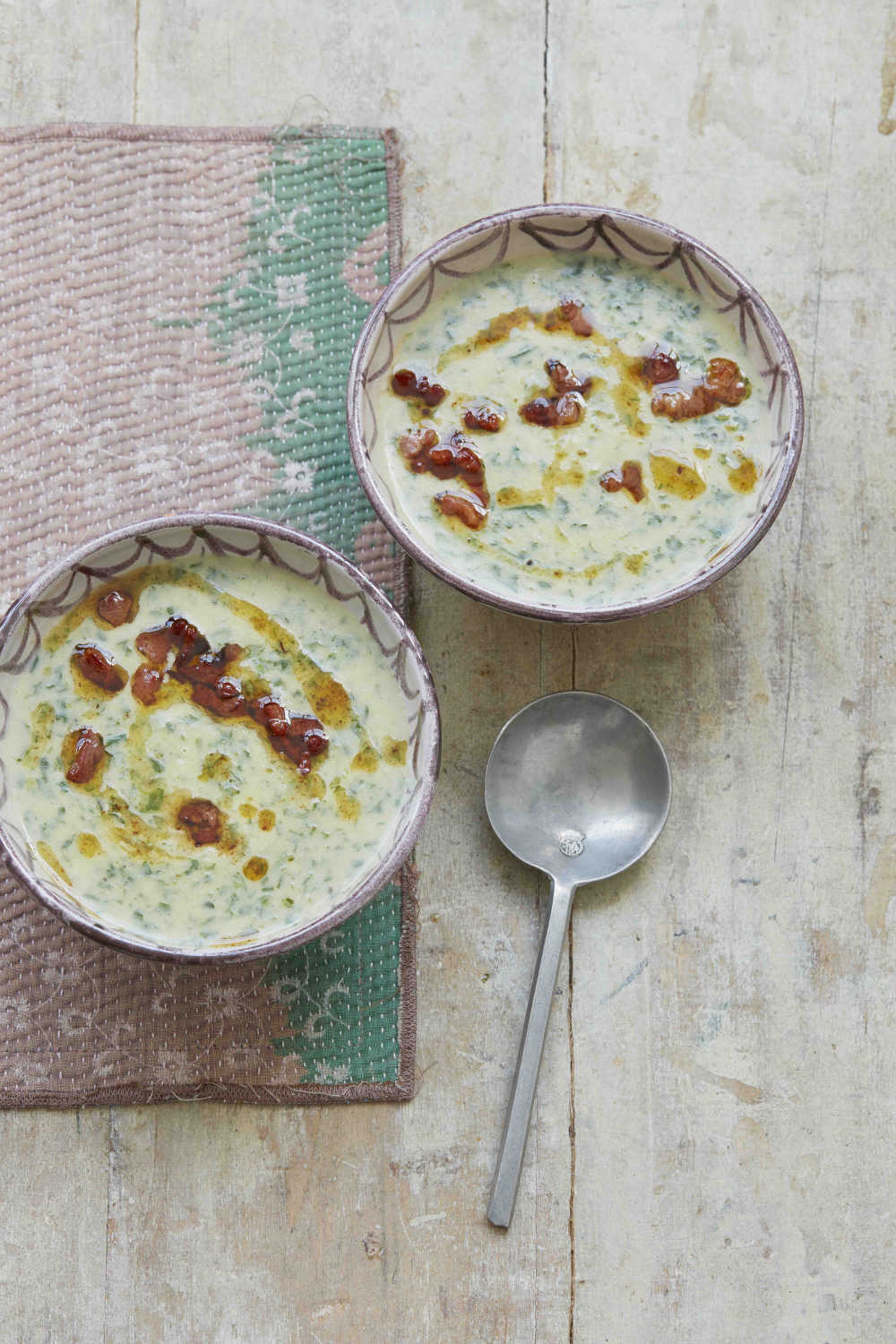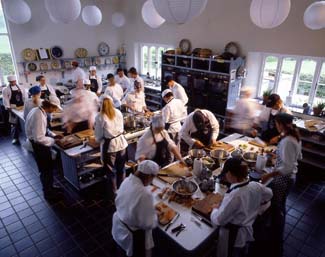The Darina Allen Column

This month Darina talks about What's Hot and What's Not for 2018
So what’s hot and what’s not on the 2018 food scene. Much energy and investment goes into predicting up-coming trends in the many areas of food production. From multinational companies to artisan producers and supermarket chains, all have a vested interest in having their finger on the pulse. Chefs too are keen to keep on top of emerging trends. So let’s have a look at what’s coming down the line.
There appear to be several strong general trends. Even though there’s a definite backlash against clean eating, veganism is still on the rise. Uber Eats reported a 400% rise in vegan searches in 2017and sales of vegan cheese increased by 300% in Sainsbury’s in the same period. Requests for meat free veggie burgers (that bleed from beetroot juice!) continue to rise. The flavour is apparently great and it ticks all the boxes for the growing demand for “cruelty free protein”. Vegetables are set to be the “new meat”. The concept of Meat Free Monday is gradually becoming more mainstream, though I have to say I can’t see the Irish chaps abandoning their beef habit in favour of a char-grilled cauliflower steak anytime soon.
The supercool brunch boom continues to build and the avocado toast craze is undimmed even as the avocado farmers struggle to supply the phenomenal demand.
The health and fitness trend continues to drive market share and foods that promise better or brain function and enhanced performance are still vaporising off shelves.
The growing body of research linking our gut health with our mental and physical wellbeing has piqued people’s interest, consequently foods that promise to improve gut and digestive health are a huge trend. Pickled, preserved and fermented foods are filling up fridges and making your own sauerkraut and kimchi is becoming mainstream among the young health conscious.
Here at the Ballymaloe Cookery School we now have a “Bubble Shed” where all the fermented foods are made and on-going experiments and classes are conducted see www.cookingisfun.ie for details of our next Fermentation course.
Foods that promote a healthy gut microbiome, natural, organic and biodynamic foods, farmhouse cheeses and organic raw B2 milk from a small herd of heritage breeds. Seek out Dan and Anne Aherne’s beautiful creamy milk at Mahon Point Farmer’s Market (Thursdays) and Midleton Farmers Markets (Saturdays), or visit the Ballymaloe Cookery School Organic Farm Shop for raw milk from our small herd of Jersey cows.
There’s a growing awareness and reaction to “food waste” issues. Chefs are now proudly boasting about serving the underused cuts of meat, so expect to see more oxtail, tongue, pigs ears, crubeens (pigs feet) and a further interest in “nose to tail eating” and “root to shoot”, where every scrap of vegetable is used rather than just the familiar section offered on the supermarket shelf.
Watch the “grow some of your own super-food movement” gather momentum in both urban and rural areas, not just for economic, social and lifestyle reasons but for mind-blowing fabulous nutrition. Check out GIY www.giy.ie, Good Food Ireland www.goodfoodireland.ie or treat yourself to a copy of Grow Cook Nourish, my latest tome, which was originally called “For God’s Sake Grow Some of Your Own Food”.
It may surprise you to learn that more health conscious millennials are limiting their alcohol consumption. The rise in booze free, homemade mocktails, fruity cordials and fizzy sodas reflects this definite super cool trend.
Chefs are buying land, growing fresh produce on their roofs or in their backyards and buying directly from local farmers and artisan food producers, will use local coast, grocers within walking distance….
Amazon has taken over Wholefoods, watch this space….
Foods to watch out for in 2018
1. Street food inspired dishes, dosa, tacos, toastadas, falafel, shawarma, bánh mì, gyros, arepas, satay, empanadas, ramen, pupusas, noodle dishes…
2. Veggie carb substitutes, zoodles (zucchini noodles), cauliflower rice is still up there.
3. Homemade or housemade condiments, artisan pickles, mustard, ketchup…
4. Buddha bowls – a bowl of greens, beans, veggies, grains, nuts and seeds with a dressing or favourite sauce – eat mindfully…
5. Chinese dumplings, wontons, steamed buns….
6. Poke, bowls of sushi rice, essentially sushi without the fuss, a raw fish salad with lots of yummy toppings on top (everyday food in Hawaii).
7. Ancient grains, farro, spelt, and quinoa of course, but also kamut, emmer, teff, sorghum, freekeh in salads, breads, biscuits….
8. Jackfruit - a hot new vegan ingredient, the largest tree fruit on the planet, nutritious, delicious with a texture and flavour of pulled pork when cooked.
9. Smoked absolutely everything, black pudding, tomato, tofu…
10. Goat meat, wild boar, more wild game in season.
11. Seaweed – all type of algae, sprinkled on, and added to, almost everything from salad and bread to ice-cream.
12. Wild and foraged foods. Look out for Winter cress, pennywort, watercress, all in season now.
13. Ethnic dips and spreads and condiments beyond sriracha, zhug, harissa, peri peri, sambal, shichimi togarashi, pixian chilli bean paste, jocguang…
14. Savoury jams and jellies not just bacon jam, try tomato jam, carrot jam, apple and seaweed jelly.
15. Heirloom fruit and vegetables, not just tomatoes and potatoes….
16. Imperfect, ugly produce, organically produced, “root to shoot eating”.
17. Bone broths still huge
18. Mushrooms are morphing into a superfood, even being added to coffee
19. Regular readers will know that I’m a huge fan of Jerusalem artichokes, another brilliant super delicious and a versatile winter root, highest in inulin of all vegetables and certainly on trend.
20. We’ll hear more of lesser known herbs, borage, sweet cicely, chervil, hyssop, lemon balm, lemon verbena, papalo and also here to fore unknown edible flowers: forget-me-not, dahlias, crysthanamums, cornflowers, daylilies…..
21. Activated charcoal and green dusts – think matcha, ras el hanout, shichimi.
22. Ethnic kids dishes, sushi, teriyaki, tacos, tostadas.
23. Mac and cheese, porridge, scrambled eggs and French fries are all getting a makeover, perfect bases for all manner of toppings and additions.
24. Turmeric – the super charged anti-inflammatory, both fresh and in dried form in everything and anything.
25. Homemade charcuterie, sausages, guanciale, blood puddings.
26. Mill you own flour and heritage grains.
27. Eggs from rare breed chickens and non-traditional breeds of poultry. Blue/green shelled eggs from Aracuna hens, Marrans, Leghorns, Light Sussex’s, Speckledeys, Hebden black hens
Here are a couple of recipes using some of these on-trend ingredients:
Ballymaloe White Yeast Bread
This loaf is always served in a traditional plait shape in Ballymaloe but it can be shaped in many forms, from rolls to loaves or even in to animal shapes! It is a traditional white yeast bread and once you have mastered this basic technique the sky is the limit.
Makes 2 x lb (450g) loaves
20g ( ¾oz) fresh yeast
425ml (15fl oz) water
30g (1oz) butter
2 teaspoons salt
15g (½ oz) sugar
675g (1½ lbs) strong white flour
Poppy seeds or Sesame seeds for topping - optional
2 x loaf tins 13 x 20cms 5” x 8”
Sponge the yeast in 150ml (5fl oz) of tepid water, leave in a warm place for about five minutes.
In a large wide mixing bowl sieve the flour, salt and sugar. Rub in the butter, make a well in the centre.
Pour in the sponged yeast and most of the remaining lukewarm water. Mix to a loose dough adding the remaining liquid or a little extra flour if needed
Turn the dough onto a lightly floured work surface, cover and leave to relax for 5 minutes approximately.
Then knead for about 10 minutes or until smooth, springy and elastic (if kneading in a food mixer with a dough hook, 5 minutes is usually long enough).
Put the dough in a large delph bowl. Cover the top tightly with cling film (yeast dough rises best in a warm moist atmosphere).
When the dough has more than doubled in size, 1½ - 2 hours, knock back and knead again for about 2 to 3 minutes. Leave to relax again for 10 minutes.
Shape the bread into loaves, plaits or rolls, transfer to a baking sheet and cover with a light tea towel. Allow to rise again in a warm place, until the shaped dough has again doubled in size.
The bread is ready for baking when a small dent remains when the dough is pressed lightly with the finger. Brush with egg wash and sprinkle with poppy or sesame seeds if using them. Or dust lightly with flour for a rustic looking loaf.
Bake in a fully preheated hot oven, 230C/450F/regulo 9 for 25 - 35 minutes depending on size.
The bread should sound hollow when tapped underneath. Cool on a wire rack.

Foragers Soup
Recipe taken from Grow, Cook, Nourish by Darina Allen, published by Kyle Books. Photography by Clare Winfield and Tim Allen.
Throughout the seasons you can gather wild greens on a walk in the countryside. Arm yourself with a good well-illustrated guide and be sure to identify carefully, and if in doubt, don’t risk it until you are quite confident.
Serves 6
50g (2oz) butter
110g (4oz) diced onion
150g (5oz) diced potatoes
250g (9oz) chopped greens – alexanders, nettles, wild sorrel, a few young dandelions, wild garlic, borage leaves, wild rocket, ground elder, beech leaves, chickweed, watercress
600ml (1 pint) light chicken stock
600ml (1 pint) creamy milk
To serve:
75g (3ozs) chorizo or lardons of streaky bacon
extra virgin olive oil
wild garlic flowers if available
Melt the butter in a heavy bottomed saucepan. When it foams, add potatoes and onions and turn them until well coated. Sprinkle with salt and freshly ground pepper. Cover and sweat on a gentle heat for 10 minutes.
When the vegetables are almost soft but not coloured add the hot stock and boiling milk. Bring back to the boil and cook until the potatoes and onions are fully cooked.
Add the greens and boil with the lid off for 2-3 minutes approx. until the greens are just cooked. Do not overcook or the soup will lose its fresh green colour.
Purée the soup in a liquidiser. Taste and correct seasoning.
Heat a little oil in a frying pan. Add the diced chorizo or lardons of streaky bacon, cook over a medium heat until the fat starts to run and the bacon is crisp. Drain on kitchen paper.
Sprinkle over the soup as you serve. Use the chorizo oil to drizzle over the soup also and scatter a few wild garlic flowers over the top if available.
---
'30 Years at Ballymaloe' - Bord Gáis Avonmore Cookbook of the Year 2013
Good Food Ireland Cookery School of the Year 2012/2013
***
 Once again, the Ballymaloe Cookery School in East Cork has a great programme of cookery courses for all interests and abilities running throughout 2018. Ranging from a relaxing visit to sit in on an afternoon cookery demonstration to a week long ‘Intensive Introductory Course’.
Once again, the Ballymaloe Cookery School in East Cork has a great programme of cookery courses for all interests and abilities running throughout 2018. Ranging from a relaxing visit to sit in on an afternoon cookery demonstration to a week long ‘Intensive Introductory Course’.
Sitting in the middle of a 100 acre organic farm the Ballymaloe Cookery School provides its students not only with a life skill learnt under the expert tutelage of their very capable teachers but also a place to relax and unwind from the stresses and strains of normal everyday life. The cottage accommodation available onsite for residential courses consists of a collection of delightful converted outbuildings which have been transformed over the years by the Allens, and other accommodation is available locally for the short courses.
www.cookingisfun.ie






There are currently no comments
Leave a comment
Not a member? Register for your free membership now!
Or leave a comment by logging in with: